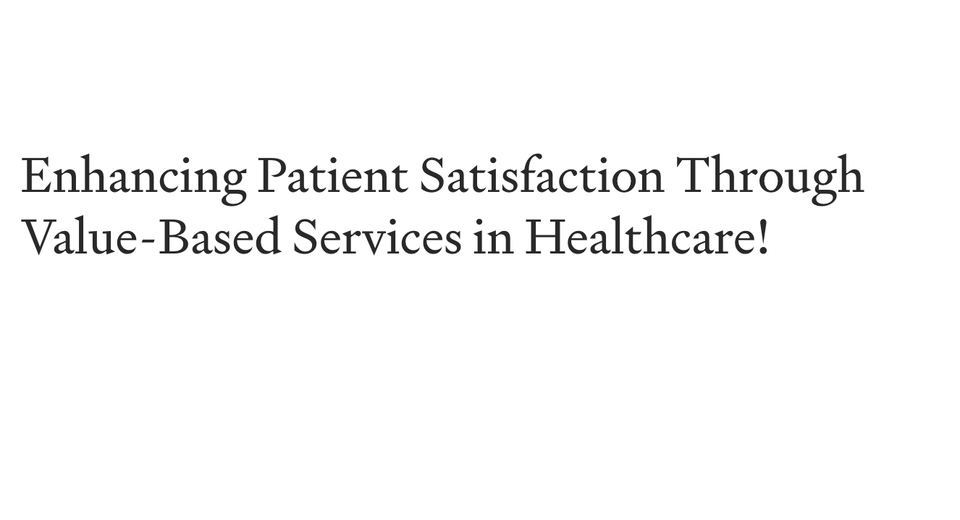Enhancing Patient Satisfaction Through Value-Based Services in Healthcare
Are You Truly Ready to Put Your Mobile or Web App to the Test?
Don`t just assume your app works—ensure it`s flawless, secure, and user-friendly with expert testing. 🚀
Why Third-Party Testing is Essential for Your Application and Website?We are ready to test, evaluate and report your app, ERP system, or customer/ patients workflow
With a detailed report about all findings
Contact us nowTable of Content
The shift towards value-based services has become a pivotal strategy for improving care quality and efficiency. As traditional fee-for-service models give way to value-based care, healthcare providers are increasingly focusing on delivering high-quality, cost-effective services that enhance patient satisfaction.
This article explores the connection between value-based services and patient satisfaction, highlighting examples of hospitals that have successfully implemented these models and achieved notable improvements in patient outcomes.
What is a Value-based Service?
Value-based services in healthcare are centered around providing care that is both effective and efficient, prioritizing patient outcomes over the volume of services delivered. Unlike traditional models, where providers are reimbursed for each service, value-based care emphasizes quality, patient-centered approaches, and cost containment.
This model encourages healthcare providers to focus on preventive care, care coordination, and patient education, all of which contribute to better health outcomes and higher patient satisfaction.
Connection to Patient Satisfaction
The integration of value-based services is intrinsically linked to patient satisfaction. By focusing on quality and efficiency, value-based care models enhance patient experiences in several ways:
- Personalized Care: Value-based care often involves tailored treatment plans that address individual patient needs, leading to greater patient involvement and satisfaction.
- Improved Care Coordination: Seamless communication and coordination among healthcare providers reduce the likelihood of errors and ensure continuity of care, which is crucial for patient satisfaction.
- Cost Efficiency: By reducing unnecessary treatments and hospital readmissions, value-based care helps patients manage healthcare costs effectively, contributing to overall satisfaction.
- Enhanced Patient Engagement: Value-based models encourage patients to take an active role in their care, fostering a sense of control and empowerment.
Examples of Hospitals Using Value-Based Models
Several hospitals have successfully implemented value-based care models, achieving significant improvements in patient satisfaction.
For instance:
- Mayo Clinic: Known for its patient-centered approach, Mayo Clinic has integrated value-based care by focusing on personalized medicine and care coordination. Their efforts have led to higher patient satisfaction scores and improved health outcomes.
- Cleveland Clinic: Cleveland Clinic has embraced value-based care through its emphasis on preventive services and innovative care delivery models. The clinic's focus on patient satisfaction is reflected in its high rankings in national surveys.
- Kaiser Permanente: As a leader in value-based care, Kaiser Permanente has implemented comprehensive care coordination and preventive health programs. These initiatives have not only reduced costs but also enhanced patient satisfaction by providing consistent, high-quality care.
Conclusion
The adoption of value-based services in healthcare is a transformative approach that aligns the interests of providers and patients, leading to improved satisfaction and outcomes. By prioritizing quality, efficiency, and patient-centered care, hospitals like Mayo Clinic, Cleveland Clinic, and Kaiser Permanente have set benchmarks for excellence in healthcare delivery.
As the healthcare industry continues to evolve, the implementation of value-based models will be crucial in achieving sustainable, patient-focused care. Healthcare providers are encouraged to embrace these models, not only for regulatory compliance but also for the intrinsic benefits they offer in enhancing patient satisfaction and overall care quality.
Further Readings
- What Is Value-Based Healthcare?
- Patient satisfaction and value based purchasing in hospitals, Odisha, India














